Shaping a phrase
When we play we should always think about how we are going to shape a phrase; where does it start?, where does it end?, where is the top of the phrase?, etc.
There are some factors you should keep in mind when you shape a phrase, such as the height of the notes, strong and weak beats, chord progressions, dynamics, and instrumentation. In this article, we will discuss how the height of the notes and strong/weak beats would affect the shaping of a phrase.
Strong beat vs the highest note
It feels natural for us to emphasize the highest notes in a phrase. Also, it comes natural for us to put emphases on strong beats.
There is no problem in deciding where the top of a phrase is when the highest note and strong beats of the phrase meet. But what do we do when they do not meet? What shall we do when the highest note is on a weak beat? Do we go for the highest note because it's the highest, or should we go for the strong beat even though the note is not the highest there.
The obvious phrasings
Let's start with easy ones. It is pretty obvious when the highest note of the phrase falls on a strong beat. Here are some examples.
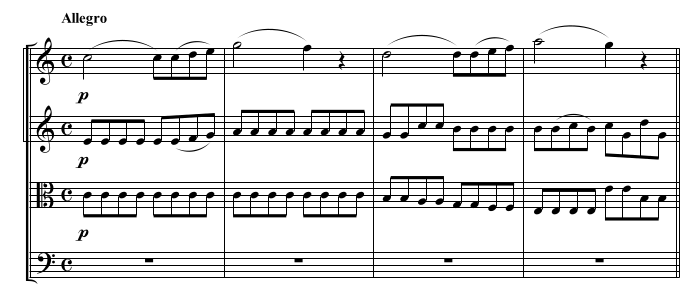
In the above example, the top of the phrase are on the downbeat of measure 2 and 4, where the notes are the highest and also where the strong beats are.
This next example is from the 1st theme in the 1st movement of the Brahms Violin Concerto.
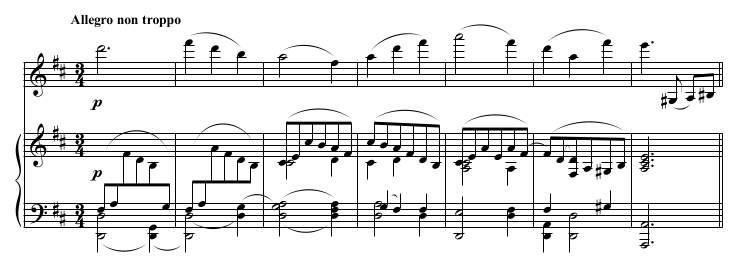
The top of the phrase is on the downbeat of measure 5. Again, the highest note is on the downbeat.
Not so obvious phrasings
Now, let's look at some examples where the highest note and the strong beat do not meet.
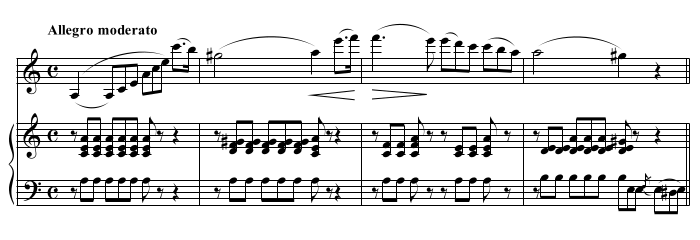
In the example of Accolay Concerto, there is a C in the 4th beat of the 1st measure. However, because it's on the 4th beat it has a sense of a pickup. Thus the top of the phrase of the first 2 measures is the downbeat of the 2nd measure.
Also, the phrase starts with a tonic chord which proceeds to a dominant chord in the downbeat of the 2nd measure. A dominant chord has a tendency to pull a phrase towards itself. This is another reason why this phrase goes to the 2nd measure, but we will not talk too much about chord progressions right now.

A similar argument can be made for the Mozart example. The orchestra does not start playing until the 3rd beat of the 1st measure. The first 2 beats are played by the solo violin only. These notes are treated as pickup notes, leading the orchestra to join in on the 3rd beat. So the phrase goes to the 3rd beat even though the highest note in at the 2nd beat.
Again, we will not go into details but the E on the 3rd beat is considered an appoggiatura. An appoggiatura is a non-chordal tone that falls on the beat. Because it is a non-chordal tone, it creates a dissonance with the rest of the notes that are happening simultaneously. The chord here is D major (D, F♯, A), the E will stick out because it does not belong to the chord. And that means the appoggiatura gains extra musical attention. This is another reason why this particular phrase goes to the 3rd beat.
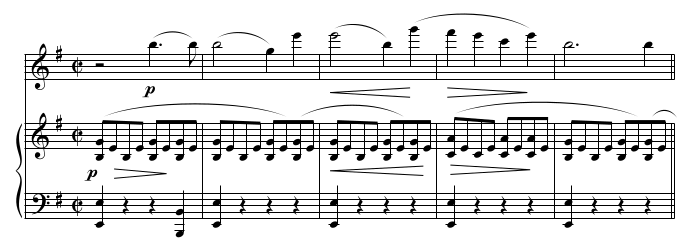
The example above is the opening phrase of the Mendelssohn Violin Concerto. The highest note is the G but that is not on a strong beat. The E at the end of measure 2, and the G at the end of measure 3 are both pickups. These notes are supposed be reaching towards the next measure.
Also, look at the chord progressions. This starts with an E minor chord (by the way, I am omitting the very first measure from the original which is another E minor chord). The chord changes to an A minor in measure 4. This demands attention, and thus, it's another reason why this phrase should go to the F on downbeat of measure 4.
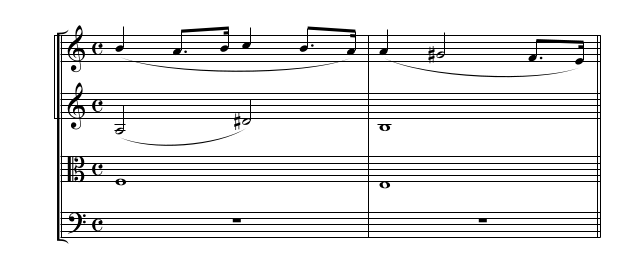
This example from Beethoven's string quartet shows yet another instance where the highest note is not on the strong beat. The highest not 'C' is on the 3rd beat, which should lead to the downbeat of the next measure. This example also shows an appoggiatura in measure 2. The 'A' does not belong to the chord which creates a clash with the E major chord. Because the dissonance in on the strong beat, we should emphasize it.
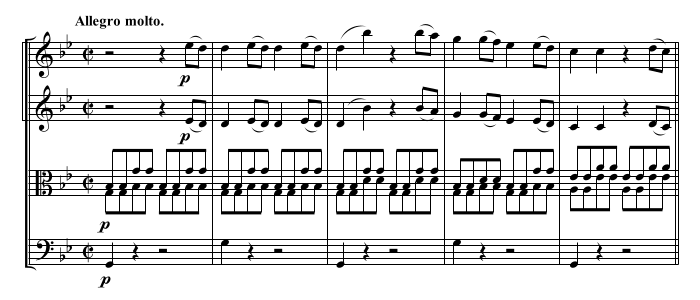
This Mozart symphony starts with two 8th notes followed by a quarter note in the violin parts. This motive repeats once, and then the 3rd time it leaps to the 'B' which is the highest note of the phrase. The music grows as the motive repeats, and the leap does catch our attention.
However, the 'B' is on the weak beat. This is a fast movement, and you can feel the downbeat in each measure as a steady pulse. If you emphasize the 'B' you will break the flow of the pulse. I don't believe that Mozart intended that kind of surprise here because everything else is flowing with a regular and constant structure, from the repeated 8th notes in the viola part to the quarter notes in the cello part, with no surprise element in either part. These are the reasons why we can say that the top of the first phrase is the downbeat of measure 3.

Look at measure 6 and 7 in this example from a Mozart violin sonata. The highest note is the C on the 2nd beat of measure 6. However, there are a few things to consider here before we say that's the top of the phrase.
First, this movement is written in 3. Generally speaking, music written in 3 has a dance-like feel to it. For instance, waltz, menuetto, and courante are all written in 3. When you play a dance music in 3, the most important beat by far is the 1st beat. The same logic should apply to this example.
Second, look at the middle voice in the piano part. You will see quarter notes C-D♯-E-F-E-D. This line clearly shows that the notes are going to the downbeat of measure 7.
Third, the 1st note of measure 7 in the violin and the piano top voice is a 'B'. This is acting like an appoggiatura, a non-chordal tone on a beat. Thus there is a clash of a major 2nd between this 'B' and the bass which is an 'A'. When there is a dissonance on a beat, it's a good idea to bring it out so that's another reason why this phrase goes to the 1st beat of measure 7.
Because of the reasons mentioned above, this phrase should go to the downbeat of measure 7 even though the highest note is on the 2nd beat of measure 6.
Takeaway
There are many aspects of music you need to examine before you decide how a phrase should be shaped. While it may be an easy solution to decide a phrasing by the height of the notes, it is important to think about the length of the notes, strong and weak beats, chord progression, dynamics, etc. along with the height of the notes.
The more you think about phrasings, the deeper you will understand music. And the more you understand music, the more interesting and sophisticated your interpretation will become.